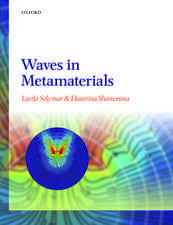The Theory of Crystal Structure Analysis
Autor A. Kitaigorodskiien Limba Engleză Paperback – 4 mai 2012
Preț: 386.81 lei
Nou
Puncte Express: 580
Preț estimativ în valută:
74.02€ • 79.15$ • 61.71£
74.02€ • 79.15$ • 61.71£
Carte tipărită la comandă
Livrare economică 18 aprilie-02 mai
Preluare comenzi: 021 569.72.76
Specificații
ISBN-13: 9781475703429
ISBN-10: 1475703422
Pagini: 288
Ilustrații: XI, 275 p. 12 illus.
Dimensiuni: 152 x 229 x 15 mm
Greutate: 0.39 kg
Ediția:Softcover reprint of the original 1st ed. 1961
Editura: Springer Us
Colecția Springer
Locul publicării:New York, NY, United States
ISBN-10: 1475703422
Pagini: 288
Ilustrații: XI, 275 p. 12 illus.
Dimensiuni: 152 x 229 x 15 mm
Greutate: 0.39 kg
Ediția:Softcover reprint of the original 1st ed. 1961
Editura: Springer Us
Colecția Springer
Locul publicării:New York, NY, United States
Public țintă
ResearchCuprins
I Mathematical Introduction.- 1 The Fourier integral and reciprocal space.- 2 Fourier transforms.- 3 Special cases of transforms.- 4 Projections and sections of transforms.- 5 Convolution of functions.- 6 Self-convolutions of functions.- II Principles of the Theory.- 1 Scattering of x-rays.- 2 Reciprocal space as the space of scattering functions.- 3 The time average of the electron density.- 4 The object considered as a system of atoms.- 5 The object as a system of particles.- 6 The form factor.- 7 Infinite o-lattices.- 8 Finite o-lattices.- 9 The ideal finite crystalline lattice.- 10 The real crystal.- 11 Structure amplitudes and products.- 12 A comparison of x-ray, electron, and neutron structure analyses.- III Structure Amplitudes and Products as Random Quantities.- 1 Statement of the problem.- 2 The distribution function of a sum of independent quantities.- 3 Gaussian representation of the distribution function of the structure amplitude of a centrosymmetric crystal.- 4 The dependence of the amplitude distribution function on the structure.- 5 Deviation of a crystal from centrosymmetry “Complete” loss of the inversion center.- 6 Statistical differences between centrosymmetric crystals and crystals without inversion centers.- 7 The distribution functions of structure amplitudes and hypersymmetry.- 8 The mean value of the structure factor and the problem of finding the unitary amplitudes.- 9 Concerning the possibility of determining the space group from intensity statistics.- 10 The distribution function of the third-order structure product.- 11 The Gaussian distribution of the structure products.- 12 The probability of a positive sign for the structure product within the limits of applicability of the Gaussian distribution.- 13 Peculiarities of incompleteaveraging of structure products.- IV The Theory of the Relations between Structure Amplitudes.- 1 Statement of the problem.- 2 Reliably positive structure products.- 3 The centrosymmetric crystal with one atom in a general position.- 4 Relationships between amplitudes and their components.- 5 Concerning the averaging of the relationships between unitary structure amplitudes and their components.- 6 The simplest inequality relating unitary structure amplitudes.- 7 Derivation of the relationships between structure amplitudes using Cauchy’s inequality. The first method.- 8 The second method of applying Cauchy’s inequality.- 9 The fundamental equation connecting structure amplitudes.- 10 Form of the connecting determinants of low orders.- 11 The determination of signs.- 12 Capabilities of the basic connecting equations for determining signs.- 13 The predominant positivity of the structure product.- 14 Finding positive structure products.- 15 Relations between the absolute magnitudes of structure amplitudes.- 16 Signs of structure products and amplitudes.- 17 The limits of possible values of structure amplitudes.- 18 Graphical representation of the connecting equations for the simplest Dm.- 19 The complete theory of the relationships between structure amplitudes.- 20 The probability of a positive sign of the structure product.- 21 Procedures for direct structure analyses.- V Analysis of the Convolution of the Electron Density.- 1 The convolution as a sum of interatomic functions.- 2 The form of the interatomic functions.- 3 Picking out the interatomic vector system from the convolution.- 4 The convolution of the electron density and crystal symmetry.- 5 Picking the structure out of the convolution.- 6 The difference inversions.- 7 Sharpening of convolutions.- VI Methodsof Obtaining Agreement between the Measured and Calculated Structure Amplitude.- 1 Antagonistic reflections.- 2 The R-factor and the correlation coefficient.- 3 General features of approximation methods.- 4 Booth’s method of “steepest descent”.- 5 Method of least squares.- 6 The differential method.- 7 The method of difference series.- 8 Accuracy factors.- 9 Computation of the errors in the determination of atomic coordinates.- 10 An approximate evaluation of the sums that enter into the error formulas.- Conclusion.











